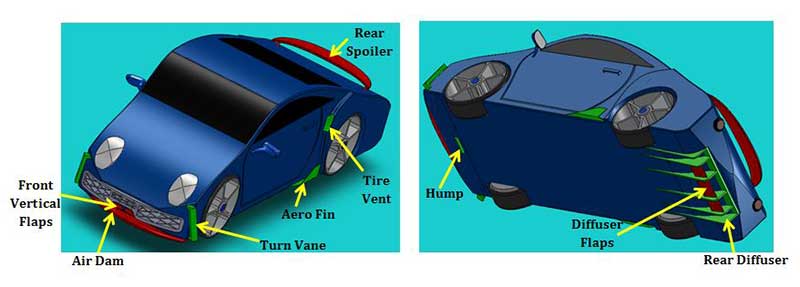Active Aerodynamics
- Basic Description
-
Aerodynamics has been incorporated into automotive design for several decades. In designing aerodynamic features on cars, two main concepts are considered: downforce and drag. Downforce uses areas of low pressure to keep the vehicle on the ground and improve handling and brake response at high speeds. However, certain aerodynamic features that increase downforce on a car also can increase drag, which forces the car to require more power to maintain a speed.
Active aerodynamics began appearing on production vehicles in the mid to late 1980's. Some of the earliest cars to carry this feature include the 1986 Porsche 959, the 1988 Volkswagen Corrado, and the 1991 Mitsubishi 3000GT VR-4. Active aerodynamic systems typically adjust certain aerodynamic features based on the speed of the vehicle. However, other information such as acceleration, yaw rate, steering wheel angle, and brake input may also be utilized. The figure below displays several aerodynamic components that are incorporated in various vehicles today. Those highlighted in green are typically integrated into the frame and are not currently part of active aerodynamic systems, while those highlighted in red are active systems in certain automobiles.
Aerodynamic Vehicle Features
-

-
The stationary aerodynamic features focus on directing the air rushing past the car to optimal locations. Tire vents, for example allow the air to cool the tires and brakes, thereby improving fuel efficiency and prolonging the life of those components. Vanes and fins direct some of the air around the car to the tire vents and increase the downforce on the car. The hump and diffuser channel the air under the car. This creates an area of low pressure, increasing the downforce and stability of the vehicle.
The active aerodynamic features enhance the performance of the stationary components. In a Porsche 911 Turbo, for example, the rear spoiler and air dam synchronously expand and retract upon reaching certain speeds. In their original, low speed position, they provide adequate downforce and stability for the car. However, their expansion at higher speeds increases stability and minimizes the drag coefficient at that speed. Front vertical flaps and rear diffuser flaps are features on the Ferrari 458 Speciale. The flaps on the rear diffuser rise to increase air extraction capacity under the car, while the front vertical flaps open to generate downforce, balancing that created by the rear flaps. The front flaps also open to direct the air flow to the turning vanes and allow more air inside the car for engine cooling. The video below demonstrates the motion of each of these active components.
Active Aerodynamics Demonstration
-
The McLaren MP4-12C has an active air brake that deploys during heavy braking at speeds above 95 kph. The air brake is a wind dam on the back of the vehicle that is deployed by a piston to its initial angle of 32 degrees. The airflow over the rear of the vehicle then forces the air brake to extend to 69 degrees. The air brake reduces braking distances by up to 20 meters.
Although most active aerodynamic systems are used in race cars, other high end vehicles have implemented some of these features. Certain BMW cars and the Ford Mustang have active grille systems that reposition at higher speeds to reduce drag when no extra cooling capacity is required. Audi also has an active design using shutters between the wheel spokes that open and close depending on the amount of air required for brake cooling.
- Sensors
- Acceleration sensor, brake pedal position sensor, engine temperature sensor, steering angle sensor, vehicle speed sensor, yaw rate sensor
- Actuators
- Air dam, flaps in front splitter and/or rear diffuser, rear air-brakes, rear spoiler, grill shutters, wheel shutters
- Data Communications
- Typically Control Area Network (CAN)
- Manufacturers
- Audi, BMW, Bugatti, Ferrari, Ford, Koenigsegg, McLaren, Pagani, Porsche
- For More Information
- [1] Automotive Aerodynamics, Wikipedia.
- [2] Auto Future: Active Aerodynamics, David Moreria, The Truth About Cars, Jan. 8, 2009.
- [3] Diffusers - Engineering Basics - Aerodynamics, Racecar Engineering, Apr. 15, 2009.
- [4] The McLaren P1: Making Hyper Advanced Aerodynamics Gorgeous, Jalopnik, Sep. 27, 2012.
- [5] 2014 Porsche 911 Turbo - Aerodynamics Engineering Video , YouTube, Aug. 16, 2013.
- [6] Ferrari 458 Speciale - Aerodynamics, YouTube, Oct. 8, 2013.
- [7] 2014 Audi 7 Retractable Spoiler, YouTube, Nov. 30, 2013.
- [8] One:1 Active Rear Wing - /Inside Koenigsegg 2, YouTube, April 8, 2014.
- [9] Active Aerodynamics, a Slippery Obsession, BBC, Aug. 19, 2014.
|

